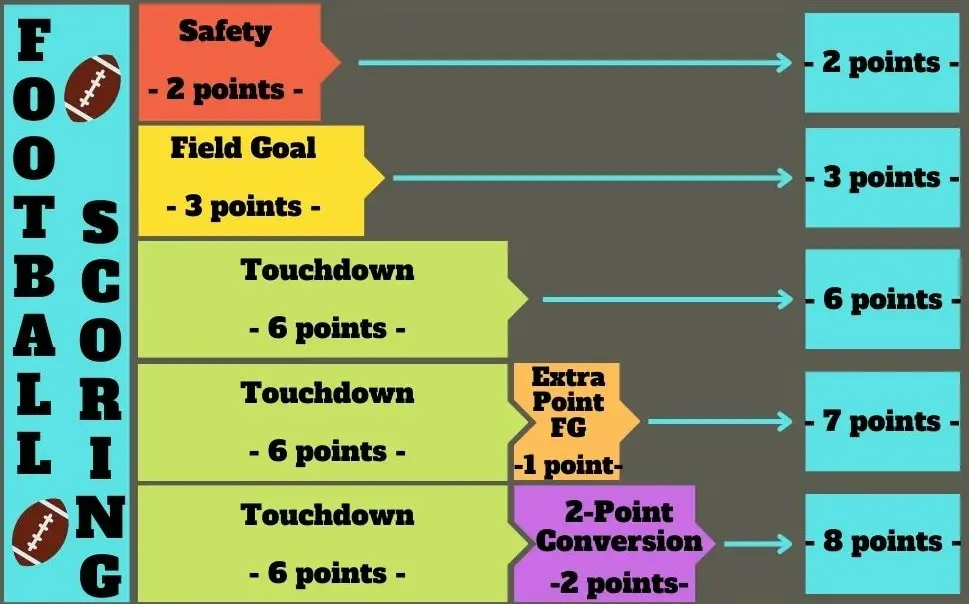

If you’re like me, you learned the rules of football at a young age from your dad, while asking way too many questions during the game. Maybe your introduction was in elementary school by your P.E. teacher…the originator of shirts vs. skins!
Since then, you may have forgotten a thing or two when it comes to scoring, game play, and some football lingo. Consider this to be your basic refresher course.
Some of you never really cared about football until now, and that’s ok. It’s good to learn new things! Whether you wanted to be a part of the game then or in the know now, this article will help you to better understand the game of football, as well as feel included in the Big Game conversation!
Object: How do you win in football?
- Score more points than your opponent in the time given
- Get the football into the opposing team’s end zone to score a touchdown
- Prevent the opposing team from getting the football into your end zone
Duration: How long is a football game?
- Four 15-minute quarters
- Each half has 3 time-outs per team
- 2 minute break between 1st and 2nd quarter
- 12 minute break between halves (half time)
- 2 minute break between 3rd and 4th quarter
- If the score is tied at the end of the 4th quarter, overtime (like another quarter) goes into effect until there is a winner (usually both teams get a chance to have possession)
Players: How many players are on a football team?
- 11 players from each team on the field at once
- American football teams (NFL) have 53 players
- The NFL, National Football League, is the major professional football organization in the United States
- The quarterback is the player that dictates the play
Want to know more about the players? Check out Football Player Positions!
The Field: How big is a football field?
- 100 yards long
- 53 1/3 yards wide
- Lines drawn along the 100 yards to note each 10 yards
- 50-yard line is in the middle, with 40, 30, 20, 10 on each side
- Two end zones (one at each end of the 100 yards), each 10 yards long and 60 yards wide
- A field goal post is in each end zone
- Total length, including end zones is 120 yards

NFL (National Football League) Season: When does Football Season Start?
- Starts the week following the first Monday in September
- Ends early January
- Throughout January, Playoff Games continue where 7 teams (4 division winners and 3 wild cards) compete, single-elimination, culminating in the Super Bowl
- The Super Bowl is usually on the first Sunday in February
Game Play and Scoring:
How do you play football? How do you get points in football?
- The game starts off with a coin toss to determine who gets first possession of the ball
- The visiting team call heads or tails
- The coin toss winner will decide if they will:
- Kick the ball to the opposing team, as the defense
- Receive the ball by having it kicked to them, as the offense
- Defer their decision until the second half of the game
– Deferring means they are able to choose to kick or receive in the beginning of the second half. In doing so, they are giving the opposing team the decision of kicking or receiving for the initial kick-off.
- The defensive team then punts (kicks) the football in a kick-off, down the field toward the offensive team from their own 35-yard line
- The offense (team with the ball) must move the ball forward (toward the opposing team’s end zone) at least 10 yards
- Players can run with or throw the ball to gain yardage
- They are given 4 chances to do this, called downs
- If they don’t succeed, the ball goes to the opposing team, who then becomes the offense – usually because players:
- Fall or get tackled (knocked down) by defense
- Run out of bounds with the ball
- Are unable to catch a pass or it is intercepted
- Run out of time in the quarter
- If they do succeed, they continue moving forward, with the downs starting over, until a touchdown is scored or the quarter is over
- Scoring a touchdown requires the offense to carry, pass, or catch the football in the opposing team’s end zone
- A touchdown is worth 6 points for the offense
- It’s important to note that the line of scrimmage (starting yard line) changes, depending on what happened at the end of the last play
- If the offense moves the ball 5 yards forward, that’s the new scrimmage line
- If the defense tackles them 5 yards back, that’s the new scrimmage line
- This all, of course, is as long as there are more downs available and nothing else has occurred, such as an interception, foul, fumble, etc.
- After a touchdown, the offense chooses one of two options to try for extra points
- One extra point option is kicking the ball from the 2-yard line (NFL) through the goal posts located in the end zone – a field goal
– An extra point field goal is worth 1 point for the offense and is chosen most often due to its relative ease.
- One extra point option is kicking the ball from the 2-yard line (NFL) through the goal posts located in the end zone – a field goal
- A different option for extra points after a touchdown is a two-point conversion
- Instead of kicking the ball for 1 point, the more difficult two-point conversion has players at the 2-yard line (NFL) to essentially score a touchdown
- The difference is that this ‘touchdown’ is only worth 2 points for the offense
- A two-point conversion is chosen most often when the score is close.
- Sometimes, on the fourth down, a team will see that a touchdown is unlikely
- Instead of trying to run or pass the ball on the fourth down, teams will opt to kick the ball and attempt a field goal from the current line of scrimmage, but get less points
- In this instance, a field goal is worth 3 points for the offense
- Another way to score points is through a safety, which is when a player on defense tackles a player on offense in their own end zone
- A safety is worth 2 points for the defensive team
- Each time a team has successfully gotten their deserved points, or is out of tries, possession is given to the other team through a kickoff from the 35-yard line
- Teams change sides of the field at the end of the 1st and 3rd quarter
- The game is over at the end of the fourth quarter, as long as the score isn’t tied
- If the score is tied, the game goes into overtime
- Overtime is basically another quarter added on, except it lasts only 10 minutes
- During regular season, there is only one overtime period allowed, which can end in a tie
- In post-game season, no ties are allowed, so if there’s a tie after both teams have had possession of the ball, sudden death overtime comes into play, meaning the next score wins the game
- There is another coin toss to determine who gets first possession of the ball
- Both teams get a chance to have the ball
- During regular season, this is true, unless the initial offensive team gets a touchdown on their first possession
Another exciting part of game play is when the football is thrown to a member of the offense, but is caught by a defensive player, an interception. This means that possession changes teams.
If the player who intercepted the football isn’t tackled, they are able to move the ball toward their scoring end zone for a touchdown, as the offensive team. If the ball is intercepted in the end zone, a player may get tackled or choose to kneel, so they’re able to take a touchback.
With a touchback, the ball automatically goes to the 25-yard line as the new line of scrimmage. Again, the interceptor’s team is now on offense and the game continues.
Tricky, right? With all this said, understanding football can still be confusing. These are truly the bare-minimum basics to help you follow most typical game play and scoring in football.
What just happened? Clipping, 15-yard penalty with automatic first down, they say?
No worries! Again, these are your be-part-of-the-game essentials. You can get to the more in-depth stuff later.

The good news is you know more about football now than you did yesterday. Plus, any football game you’re watching on tv has a score box to help you along.
Now, go watch the game and be confident in your conversations! Keep this article handy as a quick reference and share it with your friends so they can do the same!













